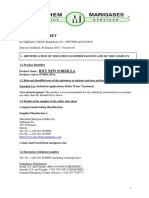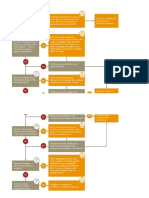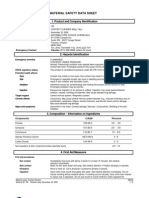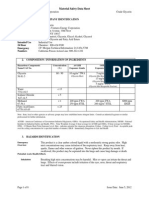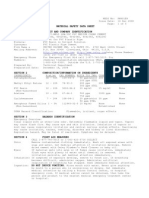Material Safety Data Sheet: Health
Material Safety Data Sheet: Health
Uploaded by
Aulia AnnaCopyright:
Available Formats
Material Safety Data Sheet: Health
Material Safety Data Sheet: Health
Uploaded by
Aulia AnnaOriginal Description:
Original Title
Copyright
Available Formats
Share this document
Did you find this document useful?
Is this content inappropriate?
Copyright:
Available Formats
Material Safety Data Sheet: Health
Material Safety Data Sheet: Health
Uploaded by
Aulia AnnaCopyright:
Available Formats
MATERIAL SAFETY DATA SHEET
1. Product and Company Identification
space
Product Name
UPC CODES
Dettol
Refer to Section 16
CAS #
Mixture
space
space
space
Antiseptic
Product use
space
Reckitt Benckiser Healthcare LTD
Dansom Lane
Hull, England HU8 7DS
In Case of Emergency: 1-800-888-0192
Transportation Emergencies: 24 Hour Number:
North America: CHEMTREC: 1-800-424-9300
Outside North America: 1-703-527-3887
Manufacturer
space
LEGEND
HMIS/NFPA
Severe
Serious
Moderate
Slight
Minimal
Health
4
3
2
1
0
Flammability
Physical Hazard
Personal Protection
3
2
2. Hazards Identification
space
Warnings: For external use only.
Do not use: in the eyes or over large areas of the body.
Ask a doctor before use if you have: deep wounds or puncture wounds, animal bites or
serious burns.
Stop use and ask a doctor if: irritation, sensitization, or allergic reaction occurs. These
may be signs of a serious condition.
Stop use and ask a doctor if: the condition gets worse or lasts more than one week.
Emergency overview
KEEP OUT OF REACH OF CHILDREN.
space
Potential short term health effects
Routes of exposure
Eye, Skin contact, Inhalation, Ingestion.
space
Eyes
May cause eye irritation. Avoid contact with eyes.
Skin
Inhalation
Discontinue use (as an antiseptic) if rash or irritation occurs.
Do not use undiluted on skin.
None expected.
Ingestion
For external use only.
space
space
space
space
Target organs
Eyes. Respiratory system. Skin.
space
Chronic effects
The finished product is not expected to have chronic health effects.
space
Signs and symptoms
Eye irritation
3. Composition / Information on Ingredients
space
Ingredient(s)
CAS #
Percent
Chloroxylenol
88-04-0
2.5 - 10
8002-09-3
2.5 - 10
67-63-0
10 - 20
Pine oil
Isopropanol
#20147
Page 1 of 7
Issue date
26-Mar-2010
4. First Aid Measures
space
First aid procedures
Eye contact
space
Skin contact
If splashed in eyes, immediately rinse eyes with plenty of water, remove any contact
lenses and continue rinsing eyes for at least 15 minutes. Consult a physician or get
medical attention.
Discontinue use (as an antiseptic) if rash or irritation occurs.
space
Inhalation
space
Ingestion
space
Notes to physician
Remove to fresh air. If irritation persists or there is any trouble breathing, get immediate
medical attention.
If swallowed, get medical help or contact a poison control centre right away.
Do not induce vomiting.
Contains pine oil.
space
General advice
If you feel unwell, seek medical advice (show the label where possible). Ensure that
medical personnel are aware of the material(s) involved, and take precautions to protect
themselves. Show this safety data sheet to the doctor in attendance. Keep out of reach
of children.
5. Fire Fighting Measures
space
Flammable properties
Combustible by OSHA criteria.
space
Extinguishing media
Suitable extinguishing media
Dry chemical. Foam. Carbon dioxide.
space
Unsuitable extinguishing media Not available
space
Protection of firefighters
Specific hazards arising from
the chemical
Not available
space
Protective equipment for
firefighters
Firefighters should wear full protective clothing including self contained breathing
apparatus.
space
Hazardous combustion products
May include and are not limited to: Oxides of carbon.
space
Explosion data
Sensitivity to mechanical
impact
Not available
space
Sensitivity to static discharge
Not available
6. Accidental Release Measures
space
Personal precautions
space
Methods for containment
space
Methods for cleaning up
Keep unnecessary personnel away. Do not touch or walk through spilled material. Do
not touch damaged containers or spilled material unless wearing appropriate protective
clothing. Keep people away from and upwind of spill/leak.
Stop leak if you can do so without risk. Prevent entry into waterways, sewers,
basements or confined areas.
Before attempting clean up, refer to hazard data given above. Small spills may be
absorbed with non-reactive absorbent and placed in suitable, covered, labelled
containers. Prevent large spills from entering sewers or waterways. Contact emergency
services and supplier for advice. Never return spills in original containers for re-use.
7. Handling and Storage
space
Handling
space
Storage
#20147
For external use only. Avoid contact with eyes. Discontinue use (as an antiseptic) if rash
or irritation occurs. Do not use undiluted on skin. Use good industrial hygiene practices
in handling this material. When using do not eat or drink.
Keep out of reach of children.
Store in a closed container away from incompatible materials.
Keep away from heat, open flames or other sources of ignition.
Keep at temperatures between 20 and 25C (68-77F).
Page 2 of 7
Issue date
26-Mar-2010
8. Exposure Controls / Personal Protection
space
Exposure limits
Ingredient(s)
Exposure Limits
Chloroxylenol
ACGIH-TLV
Not established
OSHA-PEL
Not established
Isopropanol
ACGIH-TLV
TWA: 200 ppm
STEL: 400 ppm
OSHA-PEL
TWA: 400 ppm
Pine oil
ACGIH-TLV
Mist: 5 mg/m3
OSHA-PEL
Not established
space
General ventilation normally adequate.
Engineering controls
space
Personal protective equipment
Eye / face protection
space
space
space
space
Avoid contact with eyes.
When handling in large quantities or responding to emergency situations, the use of
appropriate eye protection is recommended.
Emergency responders should wear full eye and face protection.
May cause mild skin irritation after prolonged or repeated use.
Hand protection
Emergency responders should wear impermeable gloves.
No special requirements under normal use conditions.
Skin and body protection
Emergency responders should wear impermeable clothing and footwear when
responding to a situation where contact with the liquid is possible.
Not normally required under normal use conditions.
Respiratory protection
Emergency responders should wear self-contained breathing apparatus (SCBA) to avoid
inhalation of vapours generated by this product during a spill or other clean-up
operations.
General hygiene considerations Washing with soap and water after use is recommended as good hygienic practice to
prevent possible eye irritation from hand contact.
9. Physical and Chemical Properties
space
Appearance
Clear.
space
Color
Brown
space
Form
Liquid
space
Odor
Characteristic Pine / Phenolic
space
Odor threshold
Not available
space
Physical state
Liquid
space
pH
9.5 (Basic)
space
Melting point
Not available
space
Freezing point
Not available
space
Pour point
Not available
space
Boiling point
Not available
space
Flash point
104.00 F (40 C) Tagliabue
space
Evaporation rate
Not available
space
Flammability limits in air, lower, %
by volume
Not available
space
Flammability limits in air, upper, %
by volume
Not available
space
Vapor pressure
#20147
Not available
Page 3 of 7
Issue date
26-Mar-2010
space
Vapor density
Not available
space
Specific gravity
0.98 (Water =1)
space
Relative density
Not available
space
Octanol/water coefficient
Not available
space
Solubility (H2O)
Miscible
space
Auto-ignition temperature
Not available
space
VOC (Weight %)
Not available
space
Viscosity
Not available
space
Percent volatile
Not available
10. Stability and Reactivity
space
Chemical stability
Stable under recommended storage conditions.
space
Conditions to avoid
Do not mix with other chemicals.
space
Incompatible materials
Acids. Oxidizers.
space
Hazardous decomposition products May include and are not limited to: Oxides of carbon.
Hazardous polymerization does not occur.
Possibility of hazardous reactions
space
11. Toxicological Information
space
Component analysis - LC50
Ingredient(s)
LC50
Chloroxylenol
6.29 mg/l/4h rat
Isopropanol
16970 mg/l/4h rat
Pine oil
Not available
space
Component analysis - Oral LD50
Ingredient(s)
LD50
Chloroxylenol
3830 mg/kg rat
Isopropanol
4396 mg/kg rat
Pine oil
3200 mg/kg rat
space
Effects of acute exposure
Eye
May cause eye irritation. Avoid contact with eyes.
space
Inhalation
Discontinue use (as an antiseptic) if rash or irritation occurs.
Do not use undiluted on skin.
None expected.
Ingestion
For external use only.
Skin
space
space
space
Sensitization
The finished product is not expected to have chronic health effects.
space
Chronic effects
The finished product is not expected to have chronic health effects.
space
Carcinogenicity
The finished product is not expected to have chronic health effects.
ACGIH - Threshold Limit Values - Carcinogens
Isopropanol
67-63-0
IARC - Group 3 (Not Classifiable)
A4 - Not Classifiable as a Human Carcinogen
Isopropanol
Monograph 71 [1999]; Supplement 7 [1987]; Monograph 15 [1977]
67-63-0
space
Mutagenicity
The finished product is not expected to have chronic health effects.
space
Reproductive effects
The finished product is not expected to have chronic health effects.
space
Teratogenicity
The finished product is not expected to have chronic health effects.
space
Synergistic Materials
#20147
Not available
Page 4 of 7
Issue date
26-Mar-2010
12. Ecological Information
space
Components of this product have been identified as having potential environmental
concerns.
Ecotoxicity
Ecotoxicity - Freshwater Algae Data
Isopropanol
67-63-0
96 Hr EC50 Desmodesmus subspicatus: >1000 mg/L; 72 Hr EC50 Desmodesmus
subspicatus: >1000 mg/L
Ecotoxicity - Freshwater Fish Species Data
Chloroxylenol
88-04-0
Isopropanol
67-63-0
96 Hr LC50 Oncorhynchus mykiss: 0.13-1.0 mg/L [static]; 96 Hr LC50 Lepomis
macrochirus: 1.3-2.1 mg/L [static]
96 Hr LC50 Pimephales promelas: 9640 mg/L [flow-through]; 96 Hr LC50 Pimephales
promelas: 11130 mg/L [static]; 96 Hr LC50 Lepomis macrochirus: >1400000 g/L
Ecotoxicity - Water Flea Data
Chloroxylenol
Isopropanol
Pine oil
88-04-0
67-63-0
8002-09-3
48 Hr EC50 Daphnia magna: 6.7 - 9 mg/L [Static]
48 Hr EC50 Daphnia magna: 13299 mg/L
48 Hr EC50 Daphnia magna: 17 - 28 mg/L [Flow through]
space
Environmental effects
Not available
space
Aquatic toxicity
Not available
space
Persistence / degradability
Not available
space
Bioaccumulation / accumulation
Not available
space
Partition coefficient
Not available
space
Mobility in environmental media
Not available
space
Chemical fate information
Not available
13. Disposal Considerations
space
Waste codes
Not available
space
Disposal instructions
Review federal, provincial, and local government requirements prior to disposal.
space
Waste from residues / unused
products
Not available
space
Contaminated packaging
Not available
14. Transport Information
space
UN/ID No. UN 1993
U.S. Department of Transportation (DOT)
Not Regulated by ground transport - See 49 CFR 173.150 (F)
#20147
Page 5 of 7
Issue date
26-Mar-2010
space
Transportation of Dangerous Goods (TDG - Canada)
Not Regulated by ground transport - See TDG Part 1.33
space
IMDG (Marine Transport)
UN 1993, Flammable Liquid N.O.S (Isopropyl alcohol,
Pine Oil), Class 3, PG III, Limited Quantity,
(Flashpoint 40C)
space
IATA/ICAO (Air)
UN 1993, Flammable Liquid N.O.S (Isopropyl alcohol,
Pine Oil), Class 3, PG III, Limited Quantity or
Consumer Commodity, ID 8000 if acceptable to the air
carrier.
15. Regulatory Information
space
US Federal regulations
This product is a "Hazardous Chemical" as defined by the OSHA Hazard
Communication Standard, 29 CFR 1910.1200.
All components are on the U.S. EPA TSCA Inventory List.
Product Registration: Registered with FDA
U.S. - CERCLA/SARA - Section 313 - Emission Reporting
Isopropanol
67-63-0
1.0 % de minimis concentration (only if manufactured by the strong acid process, no
supplier notification)
space
Occupational Safety and Health Administration (OSHA)
Yes
29 CFR 1910.1200 hazardous
chemical
space
#20147
Page 6 of 7
Issue date
26-Mar-2010
space
Superfund Amendments and Reauthorization Act of 1986 (SARA)
Immediate Hazard - Yes
Hazard categories
Delayed Hazard - No
Fire Hazard - Yes
Pressure Hazard - No
Reactivity Hazard - No
No
Section 302 extremely
hazardous substance
Section 311 hazardous chemical Yes
space
space
space
Clean Air Act (CAA)
Not available
space
Clean Water Act (CWA)
Not available
space
State regulations
This product does not contain a chemical known to the State of California to cause
cancer, birth defects or other reproductive harm.
U.S. - California - 8 CCR Section 339 - Director's List of Hazardous Substances
Isopropanol
67-63-0
U.S. - Massachusetts - Right To Know List
Present
Isopropanol
67-63-0
U.S. - Minnesota - Hazardous Substance List
Present
Isopropanol
67-63-0
Present
U.S. - New Jersey - Right to Know Hazardous Substance List
Isopropanol
67-63-0
Pine oil
8002-09-3
U.S. - Pennsylvania - RTK (Right to Know) List
sn 1076
sn 2684
Isopropanol
67-63-0
U.S. - Rhode Island - Hazardous Substance List
Environmental hazard
Isopropanol
Toxic; Flammable
67-63-0
space
Inventory status
Country(s) or region
United States & Puerto Rico
Inventory name
Toxic Substances Control Act (TSCA) Inventory
On inventory (yes/no)*
Yes
A "Yes" indicates that all components of this product comply with the inventory requirements administered by the governing country(s)
.
16. Other Information
space
Disclaimer
space
Further information
space
Issue date
This product should only be used as directed on the label and for the purpose intended.
To the best of our knowledge, the information contained herein is accurate. However,
neither the above named supplier nor any of its subsidiaries assumes any liability
whatsoever for the accuracy or completeness of the information contained herein. Final
determination of suitability of any material is the sole responsibility of the user. All
materials may present unknown hazards and should be used with caution. Although
certain hazards are described herein, we cannot guarantee that these are the only
hazards that exist.
12496-00044 - Dettol - 25.35 fl.oz. (750 mL) - 930666
12496-00043 - Dettol - 16.90 fl.oz. (500 mL) - 930666
12496-00042 - Dettol - 8.45 fl.oz. (250 mL) - 930666
12496-00047 - Dettol - 4.22 fl.oz. (125 mL) - 930666
26-Mar-2010
space
Effective date
15-Mar-2010
space
Prepared by
Reckitt Benckiser Regulatory Department 800-333-3899
space
Other information
#20147
For an updated MSDS, please contact the supplier/manufacturer listed on the first
page of the document.
Page 7 of 7
Issue date
26-Mar-2010
You might also like
- The Health & Safety Guide for Film, TV & Theater, Second EditionFrom EverandThe Health & Safety Guide for Film, TV & Theater, Second EditionRating: 4 out of 5 stars4/5 (1)
- BWT New FormulaDocument16 pagesBWT New FormulaArdyas Wisnu BaskoroNo ratings yet
- Bill of Lading SHORT FillableDocument1 pageBill of Lading SHORT Fillablemakro logisticaNo ratings yet
- SSAFE Food Fraud Vulnerability Assessment Tool 1 1 OkayDocument25 pagesSSAFE Food Fraud Vulnerability Assessment Tool 1 1 OkayAulia Anna100% (3)
- Traceability SOPDocument6 pagesTraceability SOPamalart99100% (1)
- Is 14489 2018Document21 pagesIs 14489 2018Rohit100% (3)
- COLAS Colprimee Info SheetDocument4 pagesCOLAS Colprimee Info Sheetsavio360No ratings yet
- EASA Operations Manual Template For Aeroplanes-Rev.6Document20 pagesEASA Operations Manual Template For Aeroplanes-Rev.6tanveer malik100% (1)
- MSDS Calcipotriol Monohydrate PDFDocument9 pagesMSDS Calcipotriol Monohydrate PDFMouna BoussettaNo ratings yet
- Contact CleanerDocument5 pagesContact CleanerlovefiezNo ratings yet
- MSDS Have 16 SectionsDocument17 pagesMSDS Have 16 SectionsBijit BiswasNo ratings yet
- Safety Data Sheet: 34078 / 1,4-Butandiol Standard Page 1 of 5Document5 pagesSafety Data Sheet: 34078 / 1,4-Butandiol Standard Page 1 of 5Elham DrsNo ratings yet
- Blue Jet Toilet Bowl Cleaner MSDSDocument5 pagesBlue Jet Toilet Bowl Cleaner MSDSanoopanil16No ratings yet
- Safety Data Sheet: 1. IdentificationDocument8 pagesSafety Data Sheet: 1. IdentificationRandomlessNo ratings yet
- Amsoil Foam CleanerDocument11 pagesAmsoil Foam CleanerDonfp ProdNo ratings yet
- Sigma-Aldrich: Material Safety Data SheetDocument8 pagesSigma-Aldrich: Material Safety Data SheetRebecaNascimentoNo ratings yet
- 7340 Iso VG 32 150 Sus Oil H43 7340Document7 pages7340 Iso VG 32 150 Sus Oil H43 7340William Lopez AyalaNo ratings yet
- Ghs Calcium Glycerophosphate MsdsDocument6 pagesGhs Calcium Glycerophosphate MsdsSRI VYJAYANTHI QANo ratings yet
- All Purpose Thinner Sep11Document4 pagesAll Purpose Thinner Sep11Paul De ChaufepieNo ratings yet
- MSDS Cat 108-8611 GrasaDocument12 pagesMSDS Cat 108-8611 Grasanauta007No ratings yet
- MSDSUFC85Document8 pagesMSDSUFC85taghdirimNo ratings yet
- Safety Data Sheet Ether, Anhydrous: Section 1 Product DescriptionDocument4 pagesSafety Data Sheet Ether, Anhydrous: Section 1 Product DescriptionSilvi TatianNo ratings yet
- Material Safety Data Sheet: (Acute and Chronic)Document4 pagesMaterial Safety Data Sheet: (Acute and Chronic)Muhammad Andhika AlfaridziNo ratings yet
- Petroleum JellyDocument6 pagesPetroleum JellyMark Evan SalutinNo ratings yet
- MSDS - Shell Mysella - Engine OilDocument7 pagesMSDS - Shell Mysella - Engine OilAnonymous LfeGI2hMNo ratings yet
- Safety Data Sheet: 1. IdentificationDocument8 pagesSafety Data Sheet: 1. IdentificationbattaNo ratings yet
- SDS Us en PDFDocument13 pagesSDS Us en PDFRicardo Carbajal RiveraNo ratings yet
- Lysol Brand III Disinfectant All Purpose Cleaner 4 in 1 US EnglishDocument7 pagesLysol Brand III Disinfectant All Purpose Cleaner 4 in 1 US EnglishpatelpiyushbNo ratings yet
- WD40Document4 pagesWD40barisalmanNo ratings yet
- Der 332Document9 pagesDer 332bd1972No ratings yet
- HONDA DW-1 ATF 08200-9008 OES (USA) and CA66844 OES (Canada)Document8 pagesHONDA DW-1 ATF 08200-9008 OES (USA) and CA66844 OES (Canada)Suri YodNo ratings yet
- XL 740htDocument6 pagesXL 740htramsi17No ratings yet
- Material Safety Data Sheet: Meropa® 68, 100, 150, 220, 320, 460, 680, 1000, 1500Document5 pagesMaterial Safety Data Sheet: Meropa® 68, 100, 150, 220, 320, 460, 680, 1000, 1500khurramNo ratings yet
- Safety Data Sheet (SDS) : Nippon Grease Co., Ltd. E4377005 Date:June 1, 2016 Page.1/5Document5 pagesSafety Data Sheet (SDS) : Nippon Grease Co., Ltd. E4377005 Date:June 1, 2016 Page.1/5Chanchai PrugpadeeNo ratings yet
- Safety Data Sheet: Xtex Pty. LTD ABN 40 121 722 236 3 Kiln Street Malaga, WA 6090 1300-00-9839 Phone 0437-272-490 MobileDocument5 pagesSafety Data Sheet: Xtex Pty. LTD ABN 40 121 722 236 3 Kiln Street Malaga, WA 6090 1300-00-9839 Phone 0437-272-490 Mobiledwalding9956No ratings yet
- THERMINOL 55 MSDS FEB2017.pdf2018-12-11 - 20 - 08 - 31 - SyP - Sga - enDocument8 pagesTHERMINOL 55 MSDS FEB2017.pdf2018-12-11 - 20 - 08 - 31 - SyP - Sga - enGanesh GanyNo ratings yet
- Material Safety Data Sheet: Product and Company Identification 1Document9 pagesMaterial Safety Data Sheet: Product and Company Identification 1Geovonni Almosthadme OsbourneNo ratings yet
- Tanoi Paste EX SDS (英語版)Document10 pagesTanoi Paste EX SDS (英語版)Afiqah YasinNo ratings yet
- Hydrogenated LanolinDocument5 pagesHydrogenated Lanolinppcool1No ratings yet
- PS 950 QTDocument10 pagesPS 950 QTJoel AlvarezNo ratings yet
- MSDS of 1,4-Dioxane (Cas 123-91-1)Document6 pagesMSDS of 1,4-Dioxane (Cas 123-91-1)DaisyfrankieNo ratings yet
- Digestion Solution For Cod 20-1500 MG L Range MTR Aghs enDocument20 pagesDigestion Solution For Cod 20-1500 MG L Range MTR Aghs enEmilia MerinoNo ratings yet
- HDAX 5200 Low Ash Gas Engine Oil-MSDSDocument6 pagesHDAX 5200 Low Ash Gas Engine Oil-MSDSAlin AspiryeNo ratings yet
- Safety Data Sheet: Identification of The Substance/preparation and of The Company/undertakingDocument4 pagesSafety Data Sheet: Identification of The Substance/preparation and of The Company/undertakingBalasubramanian AnanthNo ratings yet
- Lockstop Primer Adhesive SDS-GreenstreakDocument11 pagesLockstop Primer Adhesive SDS-Greenstreakrobox514No ratings yet
- MSDS For Crude GlycerinDocument8 pagesMSDS For Crude GlycerinGoh AiklengNo ratings yet
- MSDS - Shell Spirax - Gear OilDocument7 pagesMSDS - Shell Spirax - Gear OilAnonymous LfeGI2hMNo ratings yet
- 7770 BP Syn Air Comp Oil Iso VG 46Document7 pages7770 BP Syn Air Comp Oil Iso VG 46VidyasenNo ratings yet
- Heavy Duty Liquid Lanolin - LanotecDocument3 pagesHeavy Duty Liquid Lanolin - LanotecBiju_PottayilNo ratings yet
- Benzene, Methyl - (Cas 108-88-3) MSDS: TolueneDocument6 pagesBenzene, Methyl - (Cas 108-88-3) MSDS: TolueneMiMi JoyNo ratings yet
- Material Safety Data Sheet: 1. Product and Company IdentificationDocument10 pagesMaterial Safety Data Sheet: 1. Product and Company IdentificationFarazNo ratings yet
- Hempel SDSDocument5 pagesHempel SDSRam TN0% (1)
- FDS-jotamastic 87 ALU Comp ADocument7 pagesFDS-jotamastic 87 ALU Comp Amahmoud_allam3No ratings yet
- Section 1. Identification: Safety Data SheetDocument10 pagesSection 1. Identification: Safety Data SheetmohamedbadawyNo ratings yet
- Boiler Sludge ConditionerDocument15 pagesBoiler Sludge ConditionerArdyas Wisnu BaskoroNo ratings yet
- 2013 01 Cumene Hydroperoxide Aldrich MSDSDocument7 pages2013 01 Cumene Hydroperoxide Aldrich MSDStpr314No ratings yet
- Material Safety Data Sheet: A264 Corrosion Inhibitor A264Document9 pagesMaterial Safety Data Sheet: A264 Corrosion Inhibitor A264MasoudTeimooriNo ratings yet
- Sylfat Dp-8 MsdsDocument7 pagesSylfat Dp-8 MsdsmisterpokeNo ratings yet
- Material Safety Data Sheet: Product and Company Identification 1Document6 pagesMaterial Safety Data Sheet: Product and Company Identification 1zubair1950No ratings yet
- Chemicals Zetag MSDS Inverse Emulsion Zetag 8844 FS - 0710Document6 pagesChemicals Zetag MSDS Inverse Emulsion Zetag 8844 FS - 0710PromagEnviro.comNo ratings yet
- Polyseal .chemmastersDocument8 pagesPolyseal .chemmastersUmesh UthamanNo ratings yet
- 001105Document8 pages001105Wilson Yecit Ortiz100% (1)
- MSDS SPN 80 - PT Tritunggal ArthamakmurDocument8 pagesMSDS SPN 80 - PT Tritunggal ArthamakmurSeftia NurfaNo ratings yet
- Pete MSDS 25038-59-9 - DakDocument6 pagesPete MSDS 25038-59-9 - Dakortizan8No ratings yet
- Chemicals Zetag MSDS Beads Magnafloc 368 - 0710Document7 pagesChemicals Zetag MSDS Beads Magnafloc 368 - 0710PromagEnviro.comNo ratings yet
- Case Food Fraud PreventionDocument17 pagesCase Food Fraud PreventionAulia AnnaNo ratings yet
- Price List Pest HerbDocument1 pagePrice List Pest HerbAulia AnnaNo ratings yet
- HV Policy Self-Assessment ChecklistDocument9 pagesHV Policy Self-Assessment ChecklistAulia AnnaNo ratings yet
- Casting Quality SheetDocument1 pageCasting Quality SheetAulia AnnaNo ratings yet
- Economic and Social Council: United NationsDocument6 pagesEconomic and Social Council: United NationsAulia AnnaNo ratings yet
- Bell MethodesDocument12 pagesBell MethodesAulia AnnaNo ratings yet
- Instructions On Installation, Operation and Maintenance For Kirloskar Pump Type DBDocument27 pagesInstructions On Installation, Operation and Maintenance For Kirloskar Pump Type DBDipesh ParekhNo ratings yet
- Product and Company Identification: Safety Data SheetDocument7 pagesProduct and Company Identification: Safety Data SheetChinmoy BaruahNo ratings yet
- Rbi Iftas Anj - Hse PlanDocument103 pagesRbi Iftas Anj - Hse Planvikrant kadam (Vikrant)No ratings yet
- Types of EmergenciesDocument12 pagesTypes of EmergenciesAfzaalUmairNo ratings yet
- Material Safety Data Sheet: Lemon D Type Fragrance 00004-Fr-001Document15 pagesMaterial Safety Data Sheet: Lemon D Type Fragrance 00004-Fr-001AmmarNo ratings yet
- Castor-Oil Penetration Test For Paper (Revision of T 462 Om-01 As A Classical Method)Document12 pagesCastor-Oil Penetration Test For Paper (Revision of T 462 Om-01 As A Classical Method)Yuly Viviana Gonzalez BarrientosNo ratings yet
- Dangerous Goods at SeaDocument20 pagesDangerous Goods at SeaDheerajKaushalNo ratings yet
- Ficha FISPQ J-Next Subly Light CyanDocument8 pagesFicha FISPQ J-Next Subly Light CyanviniciusFSSFNo ratings yet
- BOYSEN Plasolux Glazing Putty B311 PDFDocument10 pagesBOYSEN Plasolux Glazing Putty B311 PDFJimson FulgarNo ratings yet
- Elastosil Aux G 3243 - MSDSDocument10 pagesElastosil Aux G 3243 - MSDSpudenaliNo ratings yet
- Msds BUSTA - PL-LC 62Document3 pagesMsds BUSTA - PL-LC 62pasebatNo ratings yet
- Irgalube 8080 SDSDocument10 pagesIrgalube 8080 SDSarmin.sosNo ratings yet
- Lego AS - SWOT AnalysisDocument3 pagesLego AS - SWOT AnalysisDUJARDINNo ratings yet
- Appxi PDFDocument803 pagesAppxi PDFonlysubasNo ratings yet
- Introduction To Safety Emergency Action PlanDocument4 pagesIntroduction To Safety Emergency Action PlanKurt StanburyNo ratings yet
- preBIULIN AGA SDSDocument4 pagespreBIULIN AGA SDSgongjuofficial.idNo ratings yet
- Storage and Display of Swimming Pool Chemicals: PermitsDocument3 pagesStorage and Display of Swimming Pool Chemicals: PermitsMina MagdyNo ratings yet
- Veloutone All DocumentsDocument32 pagesVeloutone All Documentshermit.scentNo ratings yet
- 31662tapioca Starch - MSDSDocument5 pages31662tapioca Starch - MSDSIndrayana PratamaNo ratings yet
- Safety Data Sheet: Hazardous Substance, Dangerous GoodsDocument8 pagesSafety Data Sheet: Hazardous Substance, Dangerous GoodsRocky RamNo ratings yet
- Calcium Ammonium Nitrate 27 SDSDocument10 pagesCalcium Ammonium Nitrate 27 SDSdavid214No ratings yet
- 2.2industrail HousekeepingDocument16 pages2.2industrail HousekeepingAizm DinaniNo ratings yet
- Module 5 DGR Emergency ResponseDocument10 pagesModule 5 DGR Emergency ResponseMinh NguyenNo ratings yet
- United Elchem PVC CementDocument5 pagesUnited Elchem PVC CementstevierayoNo ratings yet
- EN Form RadDocument2 pagesEN Form RadVmnascimentoNo ratings yet
- Bastion Exterior UV Stabilised WPU MembraneDocument8 pagesBastion Exterior UV Stabilised WPU MembraneGuruNo ratings yet

